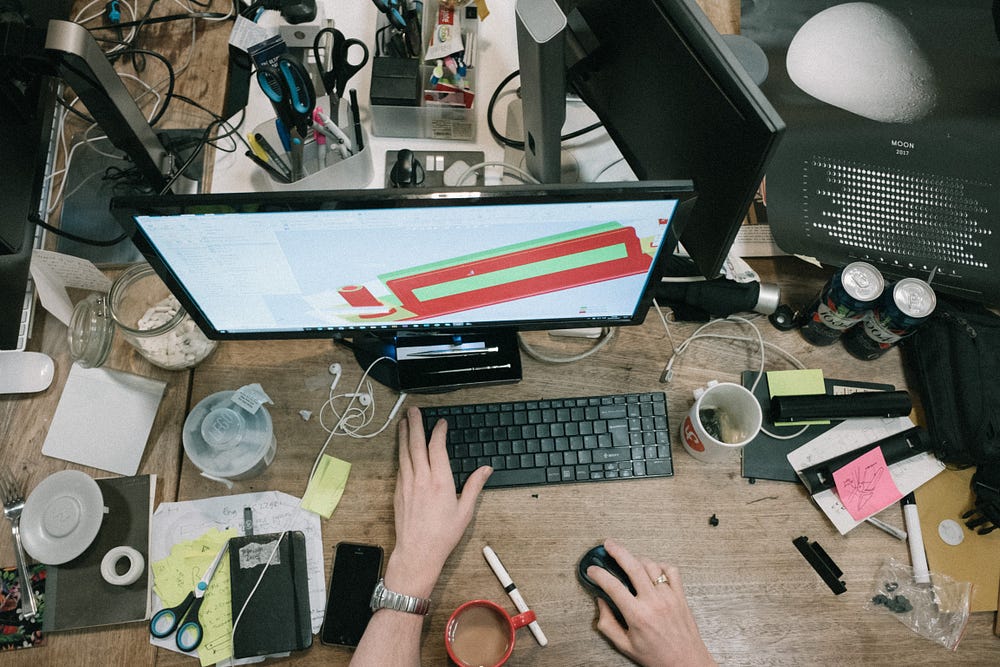State of UX in 2019
Designers are too busy to design
We are busy being busy. Busy preparing the A and the B variations to test, busy setting up remote testing sessions, busy updating the prototype URL in the Trello card. To keep our heads above the water and be able to scale our practice, we need to rethink how we focus our time.

The frenetic pace of our industry’s hyper-growth mindset has made us bad at design. We are investing so much energy in everyday tasks that it feels like a big part of our process has been taken over by the need to move faster and meet unrealistic business goals.
We are heads down discussing whether that hex color is on- or off-brand, ignoring the fact our brand guidelines haven’t been revisited in more than three years. Are we spending our energy in the right place?
Habits are hard to break. We have become quite attached to the methods we use each day. We aim for efficiency and reliability, but in doing so we get trapped in our little comfort zone. We ask for clear goals and a clearer roadmap, but we get stuck iterating the same feature over and over. We want to be bold in our vision, but we get stuck in group thinking. We want to learn from research, but we don’t have the bandwidth to act on the insights we receive.
When we finally become aware of our inability to make progress, it is often too late. The next step, often, is to pause day-to-day work to rethink our longer-term vision and strategy. Many times, we hire an external consultancy firm to do the thinking for us. While it can be insightful to bring fresh eyes to a problem, strategic explorations shouldn’t be outsourced entirely or framed as a one-off project. They should be part of our everyday decisions. They should be part of our company ethos.
What is a strategy after all?
Paraphrasing the definition from Playing to Win, by A.G. Lafley and Roger L. Martin: a strategy is just an integrated set of decisions that we make all the time.
Simple, right?
Here’s what strategy is not:
- Strategy is not (just) a vision: you need to plan, act, and iterate. Strategy needs to be realistic and help achieve tangible business goals.
- Strategy is not (just) a plan and guidelines: if you have a vision, but not the resources, it will never be materialized. If you follow guidelines and best practices, you will have a good product, but it might not be a successful one.
- Strategy is not (just) optimization: yes, successful products must be continuously optimized. But that can’t be our whole plan. Often, there is some resistance to long-term planning in the tech industry, but if you’re solely focused on small optimizations, you might be missing out on more significant opportunities.
- Strategy is not complicated: it’s about making simple, courageous choices about what you will and will not do to keep the company focused and in motion.
How can I be more strategic at work?
You still have to deliver on your daily tasks, but you also have to find a way to break the bad habit of having your work on autopilot:
- When designing, start with a concept. Concepts are simple metaphors we can use to help people understand how a system will work, before getting too attached to the details.
- Prototype the most radical idea first. As Jason Fried said: “When prototyping, always try wackier/quirkier stuff first. The deeper you get into a project, the more conservative it tends to get. Stranger ideas are more at home earlier in the process.”
- Advocate for less. Or as Julie Zhuo states: prioritize and cut. “When the discussion becomes ‘should we ship this mediocre thing, or should we spend additional time that we don’t have to make it better?’ the battle has already been lost. The thing we failed to do weeks or months ago was cutting aggressively enough. Either this thing matters, in which case make it great — don’t make it mediocre. Or it doesn’t, in which case, don’t work on it in the first place.”
- Practice zooming in and zooming out of your designs: force your brain to be idle; test your design in a different screen (print them out!); share your design earlier and often, talk aloud about it; write a summary of your idea; write the case study while you work on it. It’s all about creating the habit.
- Be patient. We like intensity. We love things that are fixed in time and easily measured. But only by staying with it for the long-run will the vision be delivered. Consistency, patience, and hard work are the keys to good design (and any other work, really).
Our industry is changing. The world around us is changing. We can’t keep doing business as usual. Soon, most of our daily tasks will be automated. If we keep our heads down, we will miss multiple opportunities for doing something more meaningful.
In 2019, we need to create time and space to stay relevant, experiment, and think more broadly about our work. Our value and impact are not defined in a feature request, but by bringing the design vision to every decision we make.
This article is part of our State of UX report: a holistic analysis of digital design as a discipline, and what to expect for the future.

